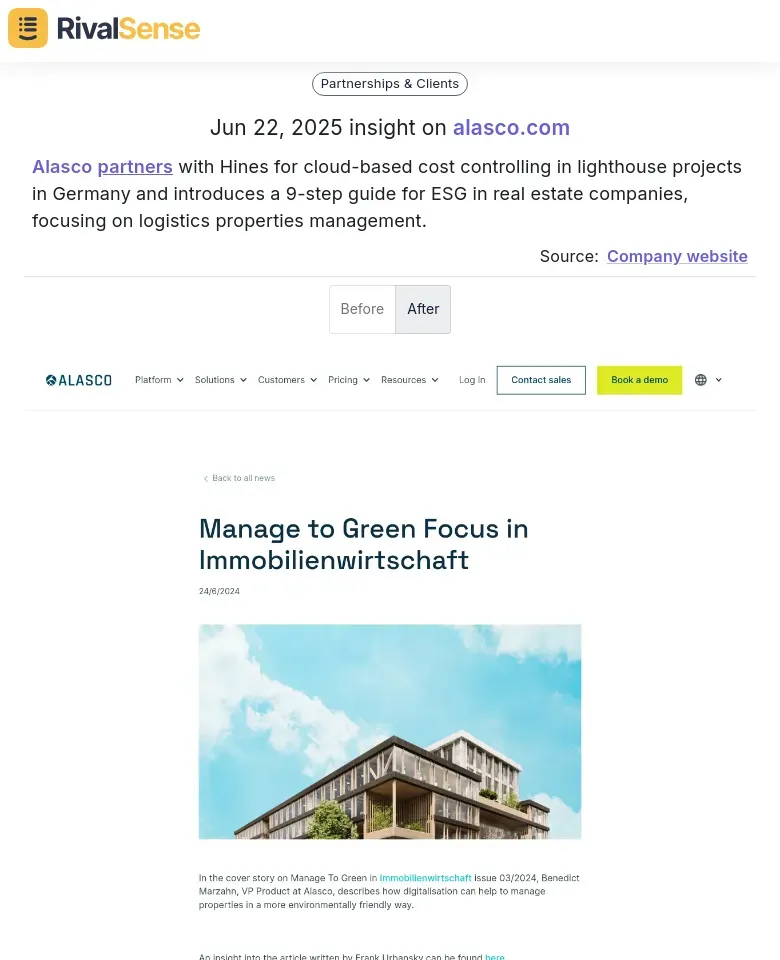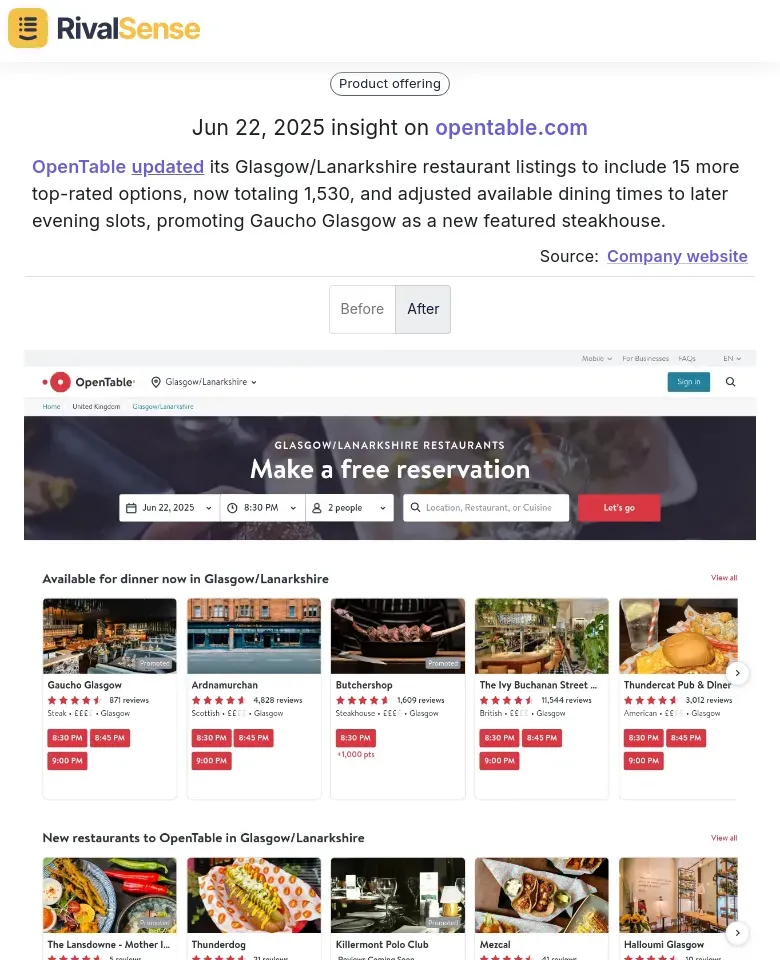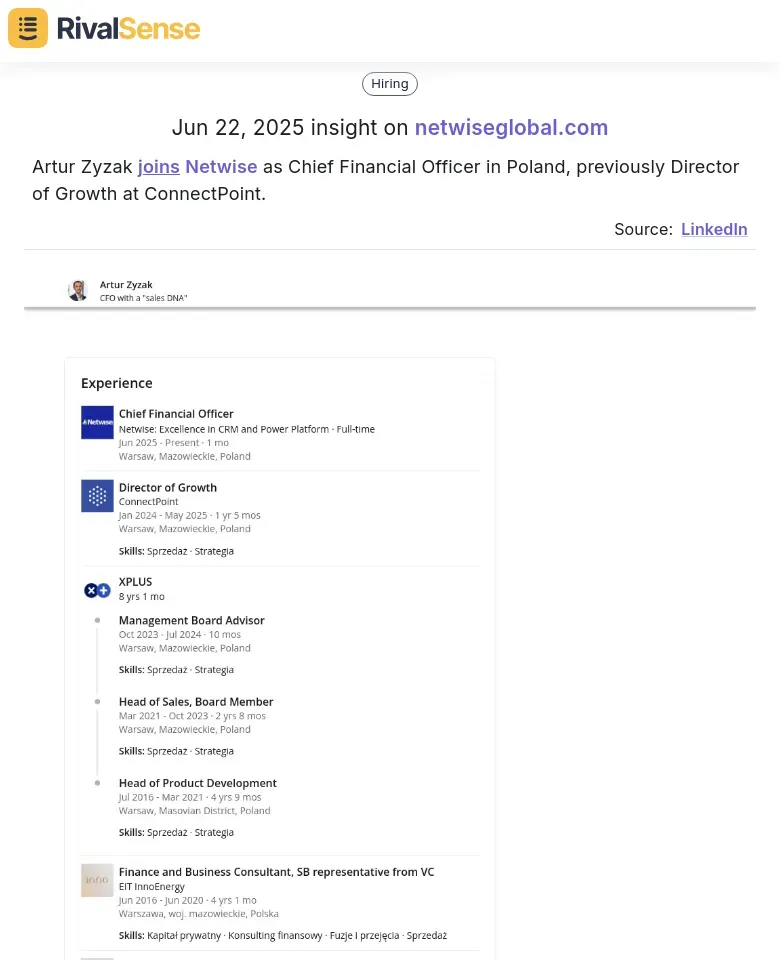Practical Approaches to Competitive Analysis: A Step-by-Step Guide
Understanding your competitive landscape is fundamental for strategic positioning. Begin by categorizing competitors into direct (similar offerings) and indirect (alternative solutions for same customer needs). For instance, a local bicycle shop's direct competitors are other bike retailers, while indirect competitors include scooter rentals or public transport apps.
Tip: Automate tracking with tools like RivalSense that monitor 80+ sources (websites, social media, registries) to surface competitor moves. Weekly reports capture critical activities like new partnerships or market expansions.
2. Analyze Competitor Offerings
Systematically compare features, pricing, and customer experience using a competitive grid. This reveals market gaps and benchmark opportunities for your business. Focus on quantifiable differentiators that impact customer decisions.
| Key Characteristics | Competitor A | Competitor B | Your Business |
|---|---|---|---|
| Product Quality | High | Medium | High |
| Price Point | $$ | $ | $$ |
| Customer Service | Excellent | Average | Outstanding |
Real-World Example:

Alasco partnered with Hines for cloud-based cost control in German lighthouse projects and launched a 9-step ESG guide for logistics real estate. Tracking such initiatives helps anticipate industry shifts—like ESG focus—and refine your own solution development.
Checklist:
- ✅ Map competitor core offerings
- ✅ Note pricing/packaging changes
- ✅ Identify underserved customer needs
3. Conduct a SWOT Analysis
A SWOT framework transforms raw competitor data into strategic insights. It highlights internal capabilities and external market dynamics to prioritize actions. Consistently update this as market conditions evolve.
- Strengths: Your advantages (e.g., faster onboarding)
- Weaknesses: Competitor edges (e.g., broader integrations)
- Opportunities: Market gaps (e.g., unserved customer segments)
- Threats: Emerging risks (e.g., new regulations)
Example: A SaaS company might list "API flexibility" as a strength and "limited mobile functionality" as a weakness after competitor benchmarking.
4. Use the Three Circles Tool
This visual method clarifies competitive differentiation by overlapping customer needs, competitor capabilities, and your offerings. The unique overlap between your solutions and unmet needs defines your USP.
- Circle 1: Customer priorities (e.g., quick implementation)
- Circle 2: Competitor strengths (e.g., advanced analytics)
- Circle 3: Your capabilities (e.g., personalized support)
Real-World Example:

OpenTable added 15 Glasgow restaurants and extended dining times—promoting Gaucho Glasgow. Monitoring such service expansions reveals competitor focus areas (like local market dominance) and potential UX improvements for your platform.
5. Leverage Social Media for Research
Social platforms offer real-time intelligence on competitor messaging and customer sentiment. Analyze engagement patterns and review sentiment to identify pain points.
- Track Trends: Monitor hashtags and industry conversations
- Analyze Reviews: Note recurring complaints about competitors
- Engage Customers: Run polls on feature preferences
Tip: Set Google Alerts for competitor names + keywords like "pricing" or "update."
6. Evaluate Business Model Feasibility
Test your model against competitor benchmarks to ensure resilience. Key questions include:
- Offering: Does our solution outperform alternatives?
- Customers: Are we targeting overlooked segments?
- Infrastructure: Can we scale faster than rivals?
- Financials: Is our pricing sustainable?
Checklist:
- ✅ Validate demand via pilot tests
- ✅ Audit resource gaps (tech/talent)
- ✅ Stress-test pricing models
7. Automate Your Competitive Analysis
Manual research consumes valuable time. Automation tools provide real-time alerts on critical developments like leadership changes or regulatory shifts, freeing resources for strategic action.
Real-World Example:

When Artur Zyzak joined Netwise as CFO after a growth role at ConnectPoint, it signaled strategic expansion plans. Tracking executive moves helps anticipate competitor investments (e.g., market entry or fundraising).
Key Automation Benefits:
- 📩 Weekly competitor activity digests
- 🔔 Real-time pricing/feature change alerts
- 📊 Regulatory update tracking
Final Thoughts
Competitive analysis fuels proactive strategy—not reactive scrambling. Implement these steps quarterly to maintain market agility and capitalize on competitors' blind spots.
Actionable Steps Recap:
- 🎯 Identify direct/indirect competitors
- 🔍 Analyze offerings via comparison grid
- 📈 Conduct SWOT assessments
- ⭕ Apply Three Circles for USP refinement
- 💡 Mine social media for trends
- 💰 Validate business model viability
- 🤖 Automate monitoring with RivalSense
Ready to outmaneuver competitors?
Try RivalSense for free and get your first competitor report today. Track product launches, pricing changes, leadership moves, and partnerships—all consolidated in weekly insights tailored for B2B leaders.
📚 Read more
👉 Competitor Intelligence in AR/VR Training: Tracking Strategic Moves Beyond Press Releases
👉 How IPRoyal's Pricing Shift Spurred Competitor Strategy
👉 Strategic Competitor Insights: Internet-Based Comparative Analysis
👉 5 Actionable Strategies to Outshine Competitor Branding in Auto Glass
👉 Beginner’s Guide to Regulatory Competitor Insights and Website Teardowns
